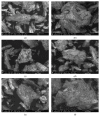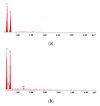Antimicrobial Activity of Cellulose Based Materials
- PMID: 35215647
- PMCID: PMC8875754
- DOI: 10.3390/polym14040735
Antimicrobial Activity of Cellulose Based Materials
Abstract
Biomaterials available for a wide range of applications are generally polysaccharides. They may have inherent antimicrobial activity in the case of chitosan. However, in order to have specific functionalities, bioactive compounds must be immobilized or incorporated into the polymer matrix, as in the case of cellulose. We studied materials obtained by functionalizing cellulose with quaternary ammonium salts: dodecyl-trimethyl-ammonium bromide (DDTMABr), tetradecyl-trimethyl-ammonium bromide (TDTMABr), hexadecyl-trimethyl ammonium chloride (HDTMACl), some phosphonium salts: dodecyl-triphenyl phosphonium bromide (DDTPPBr) and tri n-butyl-hexadecyl phosphonium bromide (HDTBPBr) and extractants containing sulphur: 2-mercaptobenzothiazole (MBT) and thiourea (THIO). Cel-TDTMABr material, whose alkyl substituent chain conformation was shortest, showed the best antimicrobial activity for which, even at the lowest functionalization ratio, 1:0.012 (w:w), the microbial inhibition rate is 100% for Staphylococcus aureus, Escherichia coli, and Candida albicans. Among the materials obtained by phosphonium salt functionalization, Cel-DDTPPBr showed a significant bactericidal effect compared to Cel-HDTBPBr. For instance, to the same functionalization ratio = 1:0.1, the inhibition microbial growth rate is maximum in the case of Cel-DDTPPBr for Staphylococcus aureus, Escherichia coli, and Candida albicans. At the same time, for the Cel-HDTBPBr material, the total bactericidal effect is not reached even at the functionalization ratio 1:0.5. This behavior is based on the hydrophobicity difference between the two extractants, DDTPPBr and HDTBPBr. Cel-MBT material has a maximum antimicrobial effect upon Staphylococcus aureus, Escherichia coli, and Candida albicans at functionalized ratio = 1:0.5. Cel-THIO material showed a bacteriostatic and fungistatic effect, the inhibition of microbial growth being a maximum of 76% for Staphylococcus aureus at the functionalized ratio = 1:0.5. From this perspective, biomaterials obtained by SIR impregnation of cellulose can be considered a benefit to be used to obtain biomass-derived materials having superior antimicrobial properties versus the non-functional support.
Keywords: antimicrobial activities; cellulose; cellulose derivatives; functionalized materials.
Conflict of interest statement
The authors declare no conflict of interest.
Figures










References
-
- Shanks R.A. 2—Chemistry and structure of cellulosic fibres as reinforcements in natural fibre composites. In: Hodzic A., Shanks R., editors. Natural Fibre Composites. Woodhead Publishing; Sawston, UK: 2014. pp. 66–83.
-
- Malmström E., Carlmark A. Controlled grafting of cellulose fibres—An outlook beyond paper and cardboard. Polym. Chem. 2012;3:1702–1713. doi: 10.1039/C1PY00445J. - DOI
-
- Malucelli L.C., Lacerda L.G., Dziedzic M., da Silva Carvalho Filho M.A. Preparation, properties and futureperspectives of nanocrystals from agro-industrial residues: A review of recentresearch. Rev. Environ. Sci. Bio/Technol. 2017;16:131–145. doi: 10.1007/s11157-017-9423-4. - DOI
-
- Khattak S., Wahid F., Liu L.-P., Jia S.-R., Chu L.-Q., Xie Y.-Y., Li Z.-X., Zhong C. Applications of cellulose and chitin/chitosan derivatives and composites as antibacterial materials: Current state and perspectives. Appl. Microbiol. Biotechnol. 2019;103:1989–2006. doi: 10.1007/s00253-018-09602-0. - DOI - PubMed
LinkOut - more resources
Full Text Sources

